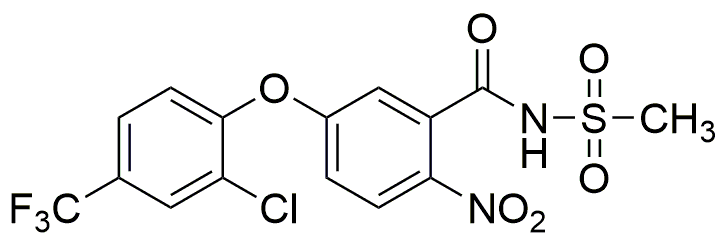Fomesafen is widely utilized in research focused on:
- Agricultural Herbicide: Primarily used in agriculture, it effectively controls a variety of broadleaf weeds in crops like soybeans and cotton, helping farmers improve yield and reduce competition for nutrients.
- Environmental Studies: Researchers study its environmental impact, assessing how it behaves in soil and water, which aids in developing sustainable farming practices and understanding herbicide resistance.
- Formulation Development: In the agrochemical industry, it serves as a key ingredient in herbicide formulations, allowing manufacturers to create products that are both effective and safe for crops.
- Integrated Pest Management (IPM): Used in IPM strategies, it helps in managing weed populations while minimizing the use of other chemicals, promoting a more eco-friendly approach to pest control.
- Research on Resistance Mechanisms: It is studied in laboratories to understand the mechanisms of weed resistance, providing insights that can lead to the development of new herbicides and management strategies.
General Information
Properties
Safety and Regulations
Applications
Fomesafen is widely utilized in research focused on:
- Agricultural Herbicide: Primarily used in agriculture, it effectively controls a variety of broadleaf weeds in crops like soybeans and cotton, helping farmers improve yield and reduce competition for nutrients.
- Environmental Studies: Researchers study its environmental impact, assessing how it behaves in soil and water, which aids in developing sustainable farming practices and understanding herbicide resistance.
- Formulation Development: In the agrochemical industry, it serves as a key ingredient in herbicide formulations, allowing manufacturers to create products that are both effective and safe for crops.
- Integrated Pest Management (IPM): Used in IPM strategies, it helps in managing weed populations while minimizing the use of other chemicals, promoting a more eco-friendly approach to pest control.
- Research on Resistance Mechanisms: It is studied in laboratories to understand the mechanisms of weed resistance, providing insights that can lead to the development of new herbicides and management strategies.
Documents
Safety Data Sheets (SDS)
The SDS provides comprehensive safety information on handling, storage, and disposal of the product.
Product Specification (PS)
The PS provides a comprehensive breakdown of the product’s properties, including chemical composition, physical state, purity, and storage requirements. It also details acceptable quality ranges and the product's intended applications.
Certificates of Analysis (COA)
Search for Certificates of Analysis (COA) by entering the products Lot Number. Lot and Batch Numbers can be found on a product’s label following the words ‘Lot’ or ‘Batch’.
Numéro de catalogue
Numéro de lot/série
Certificates Of Origin (COO)
This COO confirms the country where the product was manufactured, and also details the materials and components used in it and whether it is derived from natural, synthetic, or other specific sources. This certificate may be required for customs, trade, and regulatory compliance.
Numéro de catalogue
Numéro de lot/série
Safety Data Sheets (SDS)
The SDS provides comprehensive safety information on handling, storage, and disposal of the product.
DownloadProduct Specification (PS)
The PS provides a comprehensive breakdown of the product’s properties, including chemical composition, physical state, purity, and storage requirements. It also details acceptable quality ranges and the product's intended applications.
DownloadCertificates of Analysis (COA)
Search for Certificates of Analysis (COA) by entering the products Lot Number. Lot and Batch Numbers can be found on a product’s label following the words ‘Lot’ or ‘Batch’.
Numéro de catalogue
Numéro de lot/série
Certificates Of Origin (COO)
This COO confirms the country where the product was manufactured, and also details the materials and components used in it and whether it is derived from natural, synthetic, or other specific sources. This certificate may be required for customs, trade, and regulatory compliance.

